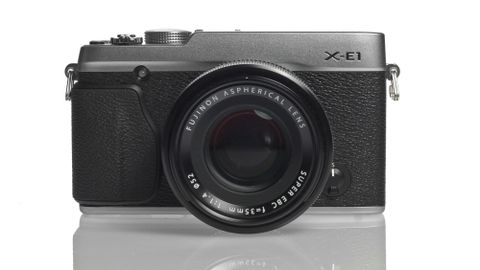Why you can trust TechRadar
Fuji's designers have once again done an excellent job with the X-E1, producing an extremely attractive body design that packs some serious photographic punch.
The body size is roughly the same as the Fuji Finepix X100, the company's premium compact camera. Despite the smaller size, lenses attached to the front of the camera don't look odd - as is prone to happening with compact system cameras (CSCs).
Although the Fuji X-E1 is smaller than the Fuji X-Pro1, it's still not a pocketable camera. It also retains a good weight to give it the same air of premium quality as its older sibling.
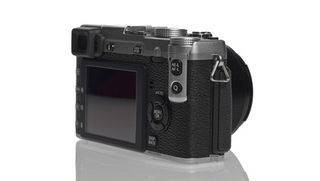
A textured grip around the front of the camera is present, which is helpful, especially when using the camera one-handed. Fuji has also introduced an additional grip, which can be attached to the camera if you require even more bulk.
Anyone familiar with the Fuji X-Pro1 will find a lot of similarities in the body of the Fuji X-E1. The top plate of the camera is almost identical, being just a little smaller and with the addition of the flash. Two dials to control exposure compensation and shutter speed sit on the top of the camera, along with a customisable Fn button.
Aperture is controlled via a ring around the lens. All of the prime optics have the aperture values written on the ring, while the 18-55mm zoom lens is text-free, since the maximum aperture is dependent on the focal length used.
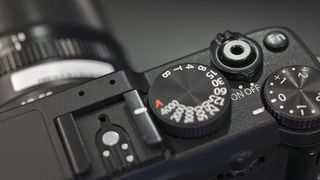
There's no fully automatic mode as such, but by switching both the shutter speed dial and aperture dial to 'A' you get a close approximation in the form of Program mode.
One thing to watch out for here is when using the new zoom lens. It can be fairly easy to accidentally grab the aperture ring instead of the zoom mechanism, leading to errors in the aperture setting if you don't pay attention.
The back of the camera is also very similar to the Fuji X-Pro1, as is the menu system. This would make a great second camera for existing Fuji X-Pro1 users.
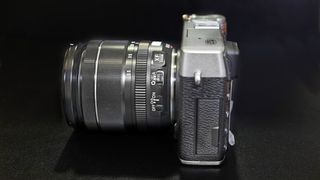
Many of the parameters of the Fuji X-E1 can be controlled via direct buttons. For instance, there's a dedicated button for Drive Mode, AF point and Macro mode.
You can push a 'Q' button recessed into the thumb grip at the back of the camera to bring up the most commonly used settings, such as white balance and ISO sensitivity.
One small criticism here is that finding the 'Q' button with a thumb while the camera is pressed to the eye can be a little tricky, especially since the thumb is drawn to the 'AE-L/AF-L' button above it, which sticks out a touch.
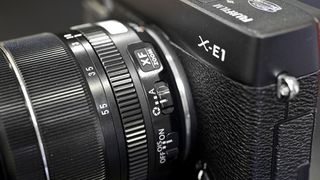
Once you find your way around the back of the camera, using it with the EVF becomes a lot easier.
The Q menu also offers the fantastic benefit of storing up to seven sets of custom settings, which can be immediately accessed. So, for instance if you regularly find yourself shooting low-light scenes, and landscapes, you could save one group with a high sensitivity selected, and the other with a low one selected.
Selecting one of the 49 autofocus points is done via the AF button on the back of the camera and then moving the point around with the arrow keys. It's easy to do, and relatively quick, though of course it would have been much quicker to implement AF changes with a touchscreen.
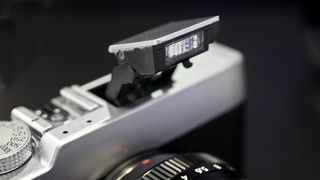
The Drive mode enables switching between single image shooting, continuous shooting, panoramic mode, various bracketing modes and - curiously hidden away - movie recording.
We can only assume that Fuji doesn't believe that users of its cameras are avid videographers, since there's no dedicated button to activate it, and you could be forgiven for thinking it doesn't offer it at all.
If you do want to regularly create videos, it might be a good idea to assign the Fn button at the top of the camera to video mode.
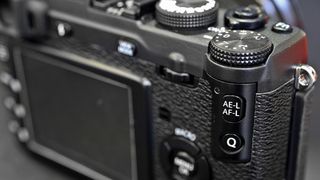
As with the Fuji X-Pro1, an eye-sensor to the side of the Fuji X-E1's EVF detects when the camera is lifted to the eye, automatically switching between the LCD screen and the EVF.
Handily, you can switch off the eye sensor via a dedicated button if you want to only use the EVF, or only use the LCD screen. The EVF itself has a soft resin on the eyepiece, which is especially useful for glasses wearers, while a dioptre dial enables you to adjust the distance between your eye and the EVF for a viewing position that best suits you.
The eye sensor reacts well and quickly, while a good angle of view from the eyepiece can be enjoyed. You don't need to be welded against it to see the display, and neither does it switch too soon as to be annoying.
Amy has been writing about cameras, photography and associated tech since 2009. Amy was once part of the photography testing team for Future Publishing working across TechRadar, Digital Camera, PhotoPlus, N Photo and Photography Week. For her photography, she has won awards and has been exhibited. She often partakes in unusual projects - including one intense year where she used a different camera every single day. Amy is currently the Features Editor at Amateur Photographer magazine, and in her increasingly little spare time works across a number of high-profile publications including Wired, Stuff, Digital Camera World, Expert Reviews, and just a little off-tangent, PetsRadar.

Nikon Z 40mm f/2 review: this cheap, modern 'nifty forty' has been my every day lens for over a year and it hasn't let me down

Could ChatGPT be the next big cybersecurity worry — researchers say it can crack systems faster than ever before

Meta Quest's software is coming to new Asus ROG and Lenovo headsets
